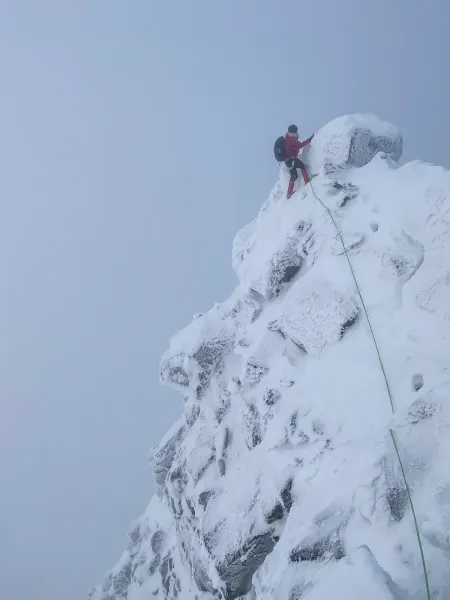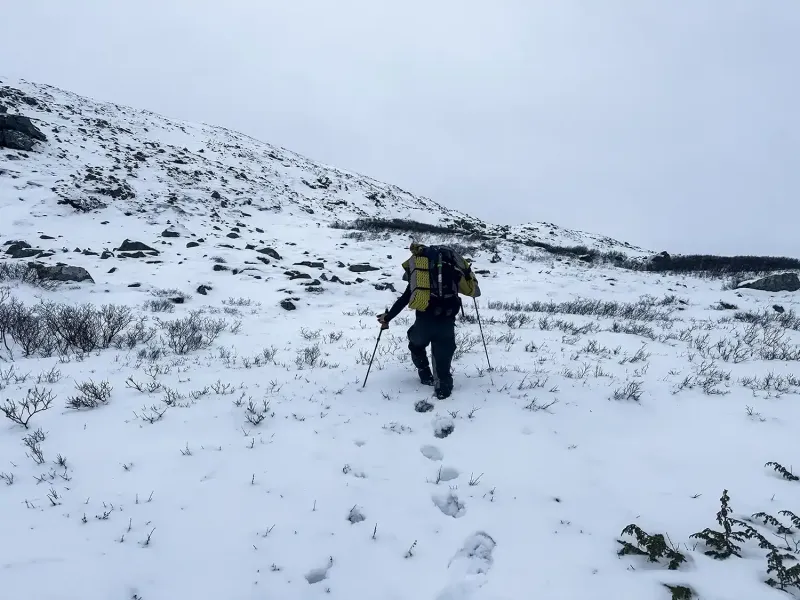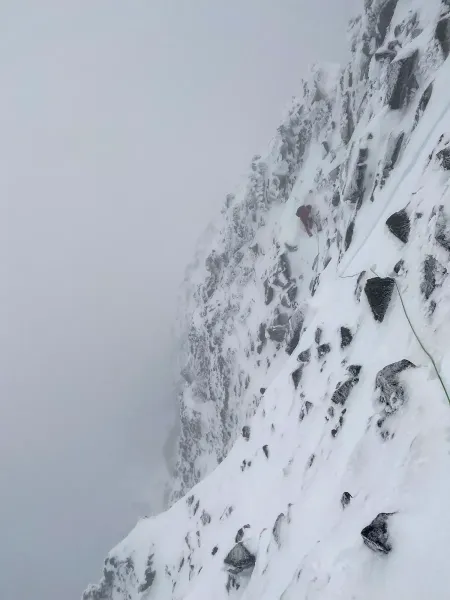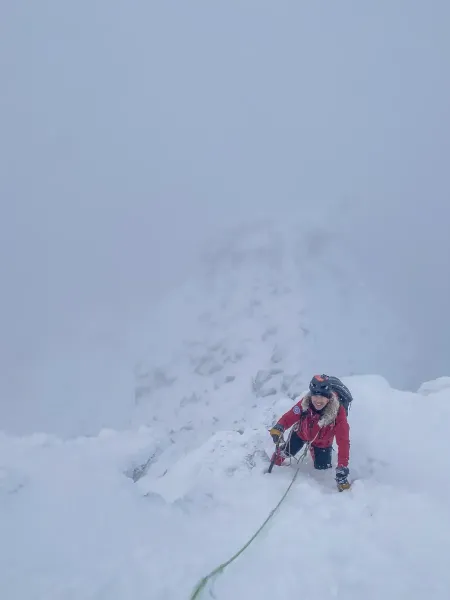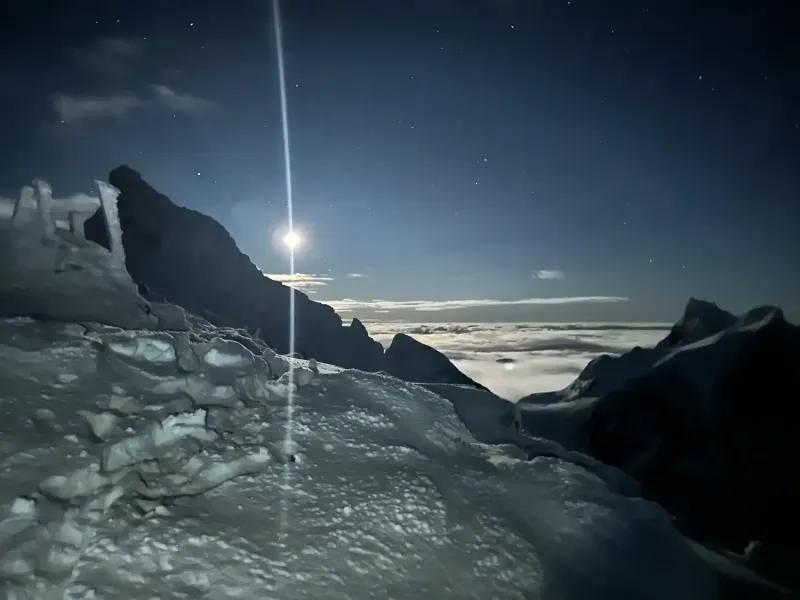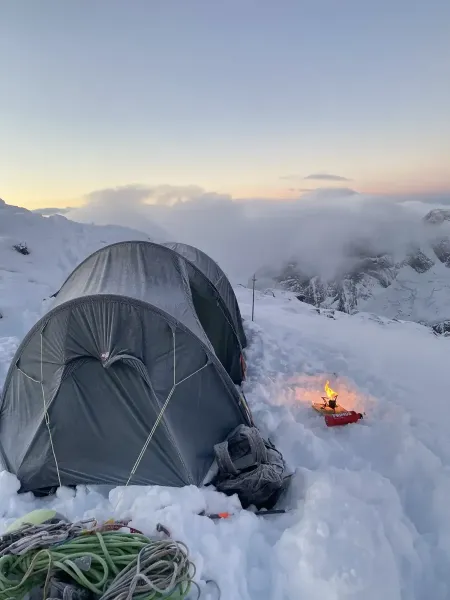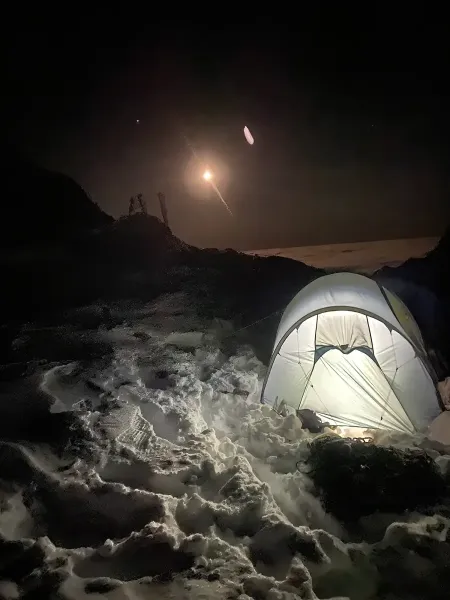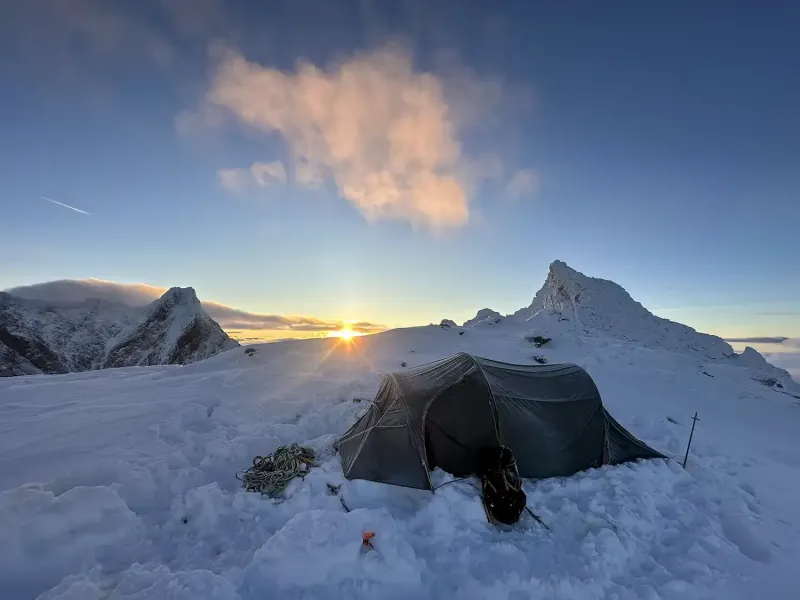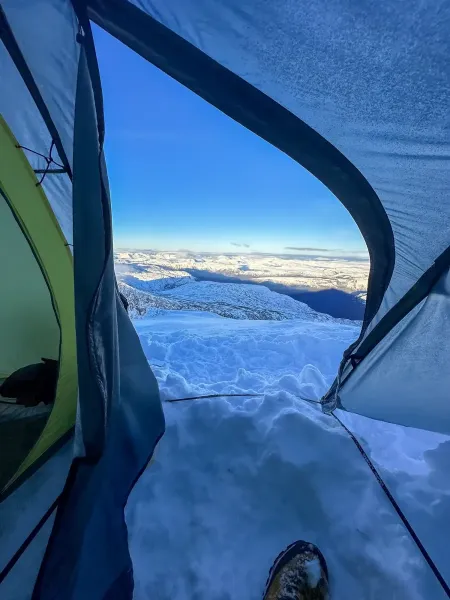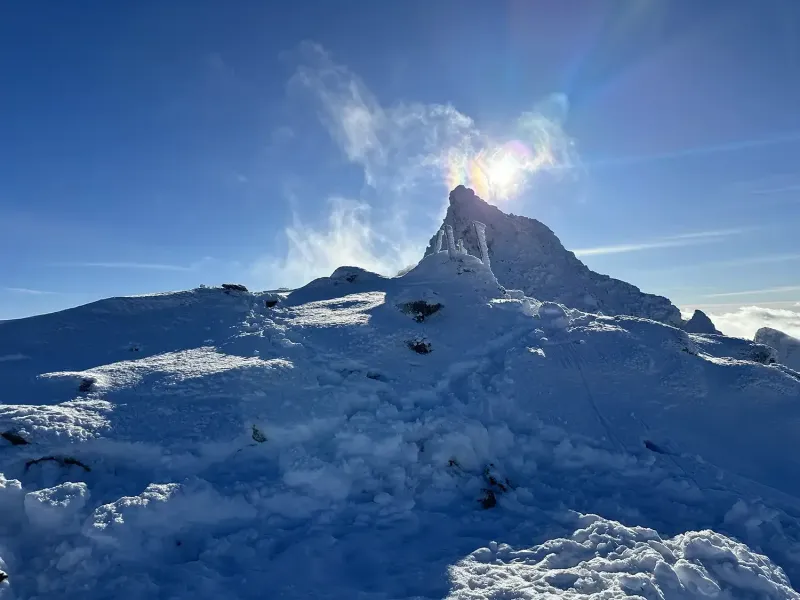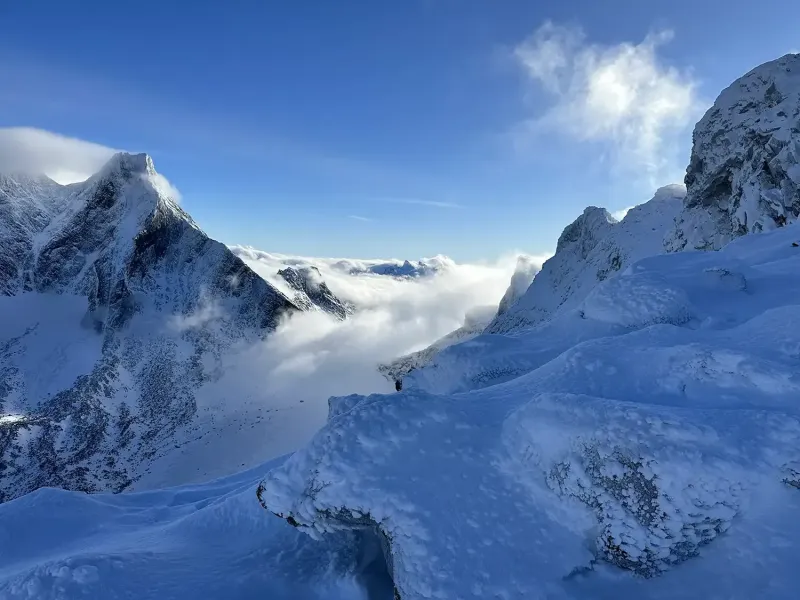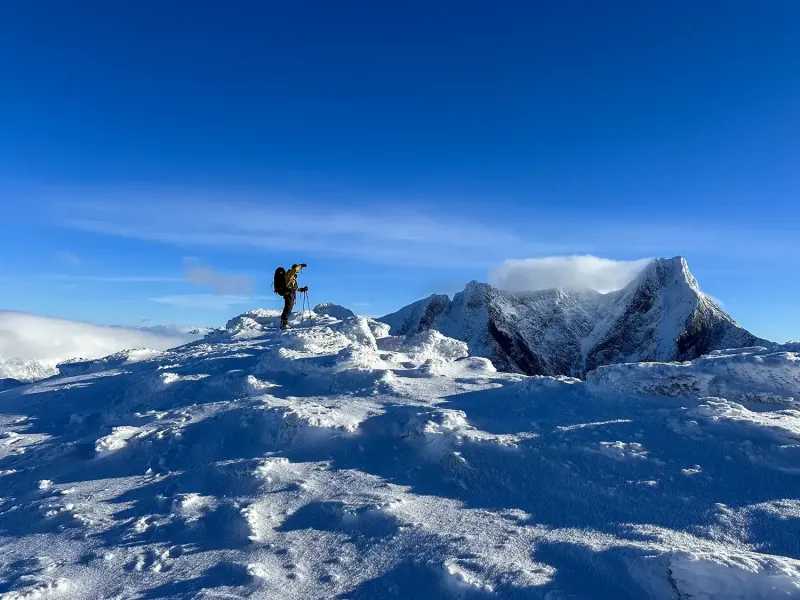Store Dyrhaugstind is the tallest peak among the Dyrhaungstindane summits. It stands at 2147 meters and has a prominence of 420 meters. End of October, my friend Gjert and I aimed to experience a winter sunset from the summit of Store Dyrhaugstind, knowing we’d have to navigate our way back in pitch-black darkness. We were not disappointed. I did not expect any climb to surpass the experience of climbing Store Skagastølstind. Still, the combination of weather, the excitement of a winter night climb, and the view gave Storen a run for its money!

Sunrise over Store Dyrhaugstind
The peak is famous for its fantastic view towards Skagastølstindane, and Storen in particular, to the east, Ringstind to the south, and Austanbotntindane to the west. In decent weather, the panorama certainly has the capacity to take one’s breath away. From glaciers and lakes to jagged peaks and vertiginous cliffs, the view from Store Dyrhaugstind offers a visual feast that could leave even the most seasoned Jotunheim explorers breathless.
See more pictures at the end of this post.
Preparations
While the actual hike towards the climb started on Monday morning, the experience started with Ferdaråd on Sunday morning, to ensure we were fully aligned on the purpose, expectations, packing lists and relevant information well before heading out. For me, Ferdaråd serves two purposes. It builds excitement during the planning process and is a mandatory safety step before any climb or alpine expedition.
As snow and ice add to the complexity of any climb, we were in full agreement to travel (ultra)light. This means one tent, ultralight equipment, and careful consideration for every single item to qualify for coming along. Certain things, such as helmets, rope, crampons and first aid, are absolutely mandatory. Equally important are sufficient warm, dry clothes, a proper heating system and shelter.
Ferdaråd
What: 2-day winter climb, nighttime if possible, of Store Dyrhaugstind. Start with daylight on day 1, and return 2 hours before sundown on day 2.
Who: Gjert and Gunnar. Gjert is my friend, mentor and IFMGA Tindevegleder from Bre og Fjell.
Weather: The forecast indicates minimal wind, cloudy with some snow, and a temperature range from -6-8°C in the daytime to -15°C at night.
Why: For the pure enjoyment, for the experience of a winter climb, and possibly add the experience of a night climb in pitch black darkness.
How: Set basecamp at Nordre Dyrhaugstind (2153m) and continue onwards to Store Dyrhaugstind with lighter packs. Sunset at the summit, and return with headlamps.
Individual kit: 50l backpack, max 12kg total, wool only, extra layers.
Shared kit: Ropes, a tent, anchor systems, cooking, first aid and camera equipment.
The entire packing list is / will be available on the Downloads section.
Setting Out: The Hike to Basecamp

Deep Snow and Boulder Approach to Store Dyrhaugstind
We set out from Turtagrø Hotel at 08:00 Monday morning and headed up Skagastølsdalen until the dam before heading further west up Dyrhaugsryggen. The scenery is stunningly beautiful, even in less-than-ideal weather conditions. Along the way, we spotted a few mountain hares, but they were too swift to capture on camera. I also realised that I hadn’t properly fastened the lid on the fuel canister for the burner. This was not only inconvenient but also quite embarrassing, as the tent and sleeping bag were now infused with the strong smell of petrol. Not my brightest moment.
The hike involved a 1,200m ascent to Nordre Dyrhaugstind, where we planned to leave our tent and overnight equipment. Usually, this section isn’t strenuous. However, the knee-deep snow and hidden boulders made it tough. We had to be extremely careful with each step. One wrong move could mean hitting a hidden boulder and risking a broken ankle or leg. To avoid getting too sweaty—since even wool gets cold when wet—we deliberately maintained a slow pace. The goal was to keep a slow and steady speed at roughly 3 km/h moving speed and plenty of breaks.
Despite our careful planning, we still ended up sweating more than anticipated. Thankfully, we’d brought along a complete change of clothes, an essential precaution for the climbing segment, as completely avoiding perspiration proved to be a challenge.
Summit Bound: The Technical Ascent to Store Dyrhaugstind

Vertical Climb towards Store Dyrhaugstind
As one of our stated goals with this climb was to experience the sunset from the summit, we anchored and buried our overnight supplies such as the tent, sleep systems, food and kitchen at the location of base camp and roped up with crampons, ice axe and helmet in order to maximise daylight.
In addition to dry clothes, we also added a few extra layers, as winter and ice climbing requires a lot of patience and time in setting proper anchor points under the snow and ice.
One main reason I got into mountaineering was to tackle my severe vertigo. So, crossing the ice and snow-covered knife-edge ridges wasn’t exactly my idea of fun. But the crampons did their job well. We were also fully secured with ropes, so although a fall would have been painful, it likely wouldn’t have been fatal. The good news about a fear of heights is that exposure therapy can really help. The first ridge was nerve-wracking, but each one got easier. When we crossed them again the next day, it felt like a walk in the park.

Approaching Store Dyrhaugstind
One of the main hazards and difficulties in winter climbing lies in identifying reliable anchor points beneath layers of snow and ice. Additionally, it’s crucial to ensure that any rocks used are genuinely secure, rather than merely superficially frozen to the surrounding terrain.
Route setting is not particularly hard. You merely follow the ridge southbound towards the summit. At the final summit, you have the choice between ascending towards east or west. From a climbing perspective, it’s relatively simple. However, the snow and ice add complexity both from an anchoring and foothold perspective.
Descending into Darkness: Nighttime Return to Base Camp

Winter Night Climb of Store Dyrhaugstind
For the way down, we took a more westerly route. Even though our headlamps lit up the area well, descending in complete darkness after sunset made things more complicated. The real challenge was figuring out which footholds were trustworthy. While being roped in made falling less dangerous, a fall could still result in pain and significant injury. After the initial descent from the peak, there is a section that is relatively steep and has sparse footholds and anchor points. The headlamps provided ample light, and more than sufficient battery capacity. The spare headlamps remained unused.

Night Tent at Store Dyrhaugstind
As the sun set, the temperature dropped noticeably and high pressure cleared the sky. We were treated to a moonlit landscape and a star-studded sky. Being over 2,000 metres up and experiencing such a crystal-clear night felt like an extraordinary gift.
Setting up camp and getting the Primus stove going felt straightforward compared to our descent in complete darkness. After such a physically demanding and emotionally rewarding experience, our Real Field Meal tasted especially good. To top it off, we were treated to a breathtaking view under a crystal-clear and icy-cold sky.
Day Two: Sunrise Splendor and a Spectacular Return

Sunrise at Dyrhaugstindene
Waking up in a tent at an altitude exceeding 2,000 m is an unparalleled privilege. Although the air carried a bit of a chill, the morning greeted us with no wind, a cloudless sky, and a breathtaking dawn. There’s something indescribable about the morning light in the mountains, and this morning we were able to take it all in from the moment we unzipped the tent’s entrance.
Roped up for a quick return over the ridges, but did not revisit the peak of Nordre Dyrhaugstind in order to make it back to the car well before dawn. The only downside was making a mess of the settings on the Insta360 X3, causing me to lose some spectacular footage from crossing the ridge.
The hike back to the car was uneventful but physically demanding. Although we were just retracing our steps, the toll of the previous day’s 10km journey and 1,200m ascent was palpable, especially on our knees. Each step seemed to remind us of the strenuous climb we had undertaken, yet the physical exertion did little to dampen the high spirits we had from our successful summit. Despite the fatigue, the experience was more than worth it, reaffirming why we find such joy in challenging ourselves in the great outdoors.
Post-Climb Debrief
Lessons Learned

Past the first Ridge towards Store Dyrhaugstind
I guess it’s pretty obvious that the biggest lesson learned is to double-check that the fuel bottle cap is securely fastened. Luckily, a few days of airing out managed to dispel the petrol smell, so no lasting harm done.
Having a complete change of clothes to switch into before climbing was essential to avoid becoming too cold while mostly stationary during the search for secure anchor points.
Finally, keeping the backpack light was far more than a mere convenience for reducing sweat and making the hike more manageable. Crucially, it served as an indispensable safety tool, significantly lowering the risk of ankle and knee injuries during both the ascent and descent.
Favourite and toughest sections
Favourite sections are most certainly traversing the ridges and reaching the top. In retrospect, the best part was probably the scariest part at the time: The nighttime descent from the summit. The powerful feeling of overcoming what at the time seemed like an impossible task is simply wonderful.

Alpine view of Skagadalen between Store Skagastølstind and Store Dyrhaugstind
Also, the crystal clear sunrise the following morning was unreal.
Favourite equipment
On every single hike, climb, or trip I take with my Brynje Expedition Jacket, I want to name it my favourite. It keeps exceeding even my increasing expectations. It has more than ample vents under the arms, all the right pockets in the right places, and zippers that can be operated with gloves. However, this time, the award for my favourite kit goes to my winter climbing boots.
La Sportiva Nepal Cube mountaineering boots.
Count on these boots to keep you warm and dry even in the most adverse weather conditions. The Vibram soles have a remarkable grip, and for ice and snow, you step right into the crampons for an easy fit. They are sturdy workhorses you can count on for the most extreme conditions you could expect in Norway.
Route Description
Please see the Downloads section for the GPX trail, or Track Me for the Garmin inReach trail.
 Park at Turtagrø Hotel, and follow the clear track in Skagadalen. Cross the creek at the dam, and follow Dyrhaugsryggen all the way up to Nordre Dyrhaugstind, which is an excellent place for basecamp, both summer and winter. To maximise daylight, bury or fasten your overnight kit there, and gear up with rope, crampons, helmet and ice axe to cover the ridges to the south. While this is a relatively easy walk during summer, I strongly recommend roping up if there’s snow and ice.
Park at Turtagrø Hotel, and follow the clear track in Skagadalen. Cross the creek at the dam, and follow Dyrhaugsryggen all the way up to Nordre Dyrhaugstind, which is an excellent place for basecamp, both summer and winter. To maximise daylight, bury or fasten your overnight kit there, and gear up with rope, crampons, helmet and ice axe to cover the ridges to the south. While this is a relatively easy walk during summer, I strongly recommend roping up if there’s snow and ice.
The track gives itself until you reach the actual summit of Store Dyrhaugstind. We climbed up towards the east and spent a significant time identifying proper anchoring points. On the descent, we chose the western route, which was more complex but less dangerous at night.
Some Statistics
Total ascent: 1318m
Total descent: 142
Min elevation: 896m
Max elevation: 2147m
Total time day 1: 10h51m
Effective moving time: 2h10m
Average speed: 1 km/h
Average moving speed: 4.6 km/h
Max speed: 8 km/h
Pictures
Unfortunately the Insta360 stopped working. At least we got some decent pictures with the iPhones. Due to the cold temperatures, the Nikon Z 30 had to stay at home.






